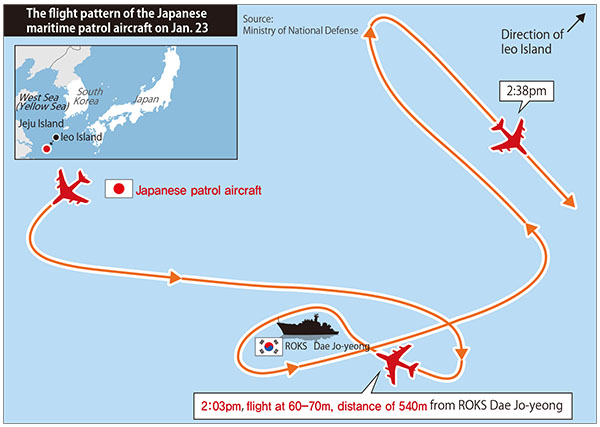Posted on : Jan.24,2019 16:05 KST
Modified on : Jan.24,2019 19:10 KST
 |
|
Seo Wook, chief director of operations at the Joint Chiefs of Staff, reports the details of a “threatening” low-altitude flyby of a Japanese patrol aircraft near a South Korean destroyer at the Ministry of National Defense briefing room on Jan. 23. (provided by the MND)
|
Episode expected to escalate S. Korea-Japan tensions
A Japanese P-3 maritime patrol aircraft performed another low-altitude flyby on the South Korean destroyer ROKS Dae Jo-yeong at around 2:03 pm on Jan. 23, approaching the vessel at an altitude of 60–70m and a distance of 540m while the destroyer was conducting operations in waters 131km to the southwest of Ieo Island.
The South Korean Ministry of National Defense (MND) called it a “clear act of provocation” and pledged to “respond sternly according to our armed forces’ rules of response if such an action happens again.” The episode suggests a renewed escalation in a conflict between the two sides that appeared to have come to an end on Jan. 21 with the Japanese Ministry of Defense’s announcement that it was suspending discussions.
 |
|
The flight pattern of the Japanese maritime patrol aircraft on Jan. 23
|
Japanese aircraft have conducted 3 flybys this year
According to the MND, Japanese maritime patrol aircraft also performed threatening flybys on Jan. 18 against a South Korean vessel operating 81km southeast of Ulsan and on Jan. 22 against one operating 83km southeast of Jeju. At around 11:39 am on Jan. 18, a Japanese P-1 maritime patrol aircraft approached to a distance of 1.8km from the South Korean destroyer ROKS Yulgok Yi Yi at an altitude of 60–70m. At around 2:23 pm on Jan. 22, a Japanese P-3 aircraft approached to a distance of 3.6km from the South Korean landing ship ROKS No Jeok Bong and the combat support ship ROKS Soyang. This means Japanese aircraft have conducted flybys three times this year alone, including the one announced by the MND on Jan. 23.
The actions of the P-3 aircraft on Jan. 23 were the most aggressive since a Dec. 20 low-altitude flyby against the destroyer ROKS Gwanggaeto the Great. In the latest case, the aircraft approached to 540m of the Dae Jo-yong at an altitude of 60–70m.
The latest low-altitude flyby by a Japanese patrol plane exhibited all three characteristics of a threatening flight pattern that the Japanese government claims to avoid by convention: directed toward a vessel, simulating attack, and proceeding toward the vessel’s bow.
“The situation at the time was filmed with a video camera and optical camera to provide an evidentiary record,” an MND official said.
Also noteworthy is the broadening of the flybys to the area near Ieo Island. In effect, Japan has been ratcheting up the intensity of its patrol aircraft’s flybys by extending the range from southeast of Ulsan to southeast of Jeju and southwest of Ieo Island.
“The waters off Ieo Island are a frequent location for operations by South Korea, Chinese, and Japanese warships and patrol aircraft,” an MND official said.
During the latest flyby, the Dae Jo-yeong issued over 20 warnings, announcing that the Japanese aircraft was “approaching our direction,” demanding that it change its flight path, and warning of “self-defensive measures” if it approached further. The aircraft showed no signs of responding. The South Korean Navy’s operational headquarters subsequently lodged a stern protest through its network with Japanese military authorities and demanded measures to prevent similar incidents.
Flybys may be ploy to get S. Korean vessels to use tracking radar
Various interpretations have been offered for the repeated flybys by Japanese patrol planes. Some have speculated that the aircraft may be attempting to goad South Korean Navy vessels into using their signal tracking and illumination radar (STIR). Japan has claimed that the Gwanggaeto the Great directed fire-control radar (STIR) against its aircraft, but has yet to produce clear evidence. Experts suggested another aim may be to play up the conflict with South Korea for domestic political ends.
South Korean Minister of Foreign Affairs Kang Kyung-wha expressed dismay over the incident to her Japanese counterpart Taro Kono during a bilateral foreign ministers’ meeting on Jan. 23 in Davos. Ahead of the meeting, Kang noted, “There have been low-altitude flybys by Japanese aircraft three times [this year] now, including today.”
“We are concerned and dismayed that this situation continues without being resolved,” she said.
By Noh Ji-won and Kim Ji-eun, staff reporters
Please direct comments or questions to [english@hani.co.kr]










